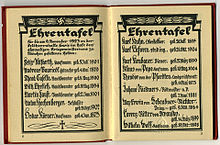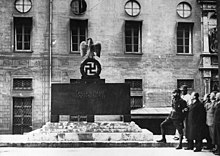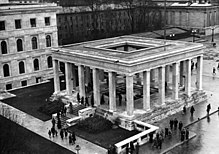Martyrdom (National Socialism)
The term martyr was used by Nazi propaganda . The aim was to create a heroic cult with regard to the Nazis who had died and were killed in connection with the efforts of the NSDAP to seize and maintain power.
Word origin
The term is a Germanization of the word " martyr " (Greek "witness"), borrowed from the Greek . Martyrs have been used in Christianity since the 3rd century to describe people who were persecuted and killed because of their Christian testimony - often in conflict with a religiously intolerant environment. In this Christian-theological meaning, the word "blood witness" is used in the German-speaking area to this day, although the older loan word "martyr" is more common. In National Socialist parlance, “blood witness” was a propaganda term that metonymically put those named in the position of martyrs.
The Nazi cult around the "martyrs"


Since National Socialism saw itself as a "movement", those killed in the political struggle were called "fallen of the movement" or "martyrs of the movement". In this phrase, the term was used in particular to refer to those 16 participants in the Hitler-Ludendorff putsch in Munich who were killed on November 9, 1923 in a clash with the Bavarian State Police . Hitler dedicated the first volume of his two-volume book Mein Kampf to them , where they were named in the foreword. After his release from prison, he had already spoken in an "appeal to former members" of the NSDAP that these sixteen men had become "martyrs" to martyrdom [martyrs] of National Socialism. In his first big speech the next day, February 27, 1925, those “who fell on November 9” were called upon as key witnesses for his efforts to unite the Volkish camp. And in a speech on March 2, 1925, Hitler spoke of the fact that the National Socialist movement had “received blood baptism” as a result of the coup. Further impetus to the so-founded cult was given to those killed in combat followers of Nazism by Hitler's order of 4 November 1925 that had hold of the Nazi local groups continue every year on November 9 commemoration in which finally killed the First World War included were, suggesting that the putschists would basically have died for the same cause as those who died in World War I: for the fatherland.
After the seizure of power by the Nazis in 1933 was at the Feldherrnhalle a plaque with the names of such persons placed in Munich, by a guard of honor of the SS was honored. Below that was a plaque with the names of the four killed police officers from the Bavarian State Police. Every passer-by who passed this board was obliged to honor it with the Hitler salute. In 1935, two "Temples of Honor" were erected on Königsplatz in Munich as a common grave for this group of people. The sixteen dead were transferred from their previous graves to Königsplatz and reburied in bronze sarcophagi , where they were included in the National Socialist cult until 1945.
"Blood Flag" and "Blood Order"
The term blood flag was already used in the Holy Roman Empire . The National Socialists picked up this again for the flag carried during the failed Hitler coup in 1923. This swastika flag was given the title " blood flag ". The first "martyrs" were: Felix Allfarth , Andreas Bauriedl , Theodor Casella , Wilhelm Ehrlich , Martin Faust , Anton Hechenberger , Oskar Körner , Karl Laforce , Karl Kuhn , Kurt Neubauer , Klaus von Pape , Theodor von der Pfordten , Johann Rickmers , Max Erwin von Scheubner-Richter , Lorenz Ritter von Stransky-Griffenfeld and Wilhelm Wolf .
The " Blood Order " was initially awarded to 1,500 people. In the course of the following years, like after the July coup , numerous other blood medals were added. In a broader sense, people like Albert Leo Schlageter , Herbert Norkus , Horst Wessel or Wilhelm Gustloff were also considered "martyrs of the movement".
After the Nazi era
Since the end of the National Socialist tyranny, these people have been referred to as putschists. They are only considered “martyrs” among members of the right-wing extremist scene . Their glorification took place, among other things, in the lavishly designed book Blood witnesses by A. K. Busch, published in 2009 by the right-wing extremist Nordland Verlag . Various neo-Nazi groups named themselves after the names of "martyrs".
Individual evidence
- ↑ Quoted from Ludolf Herbst : Hitler's Charisma. The invention of a German messiah. Frankfurt a. M. 2010, p. 212. This appeal was printed in the Völkischer Beobachter of February 26, 1925.
- ↑ a b c Quoted from Herbst (2010), p. 212.
- ↑ The book was reviewed by: Elmar Vieregge: National Socialist Martyr Cult. AK Busch “martyrs” . In: Uwe Backes, Eckhard Jesse (Ed.): Extremism & Democracy . 22nd year (2010), Baden-Baden 2010, pp. 308–312.
- ↑ Tobias Großekemper: Is there a pattern behind the NSU crime scenes? In: WAZ (online edition), June 14, 2016, accessed on June 18, 2016.
